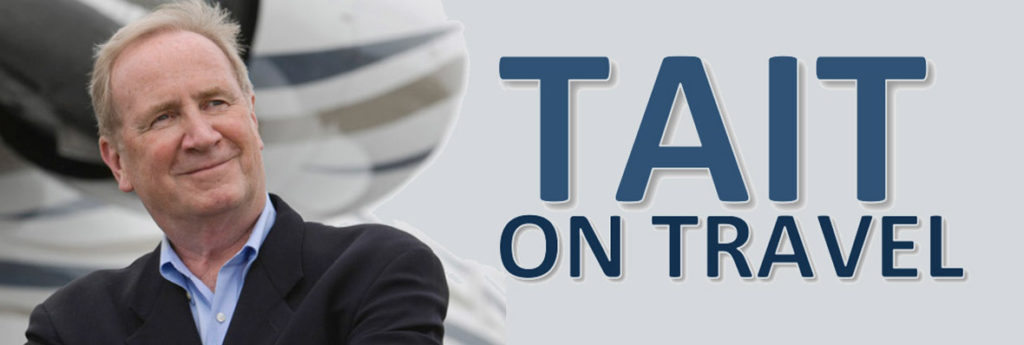The only thing I can think of that’s more challenging than explaining cricket to someone who’s never seen the game, has to be trying to defend airline pricing.
I once saw a very prescient cartoon in which a travel agent was saying to a bewildered looking customer, “I’m sorry sir, but if you were only going further away, I could almost certainly find a much cheaper airfare” – truly the definition of ‘many a true word is spoken in jest’.
I’ve always thought it a pity that, in good conscience, airlines can’t take advantage of some of the fare anomalies that they spit out on a regular basis: Right now for instance, to help promote their full time entry into the transatlantic fray, WestJet could be advertising in the Toronto market:
“Fly to London for less than New York City.”
It would certainly get a lot of attention but most of it would be far from positive. The fact is however that, looking at a few upcoming dates in February, a one-way seven-hour-plus B787 flight from YYZ to LGW can be had for as little as $188. Seriously!
If instead you want to fly the 90-minutes to New York’s LaGuardia, it can cost over $300. Similarly, in February, an economy ticket on a non-stop WestJet flight from Calgary to London, can be had for about the same price as a ticket to Toronto.
During my recent spell of commuting almost every other week between New York and Edmonton, I got to look at our business through the eyes of a consumer and was frequently ‘gobsmacked’ at some of the pricing anomalies I stumbled upon. How for instance could a New York to Edmonton ticket, with a short online connection in Toronto, possibly cost less than just LGA-YYZ – especially when it originated on the same sector? But, every once in a while, it would happen. Maybe it was a revenue management system glitch, who knows? But one has to wonder how many savvy Toronto-bound flyers would simply no-show for the second leg.
As crazy as this example is, at least round-trips are now universally (I believe, but please correct me if I’m wrong) based on sum-of-sector pricing. I recall at Wardair we used to sell a lot of ‘Advance Purchase Excursion Fares’ (APEX fares). These were based on date of departure, strictly round-trip and had to be purchased at least 21 days prior to travel. The fact that an APEX was also cheaper than most of Air Canada and other scheduled carriers’ one-way fares was irrefutably responsible for a lot of no-shows on the return sectors. I suppose those empty seats saved us fuel and we had their money, but it was not the smartest mode of pricing.
Since then of course revenue management systems and the advent of ‘dynamic pricing’, means that any single fare can and will change dramatically in the blink of an eye – not just once but multiple times per day.
In my unfortunate role as the neighborhood repository for all negative airline stories, this has become one of the most common, “D’ya wanna to hear what airline X did to me yesterday” stories. Just last week, a friend who had recently gone on a golf trip to the Caribbean with a group of five buddies, told me how they’d all booked their trip within hours of each other but no two of them had paid the same fare: one, he said, was almost 50% higher than the average of the others – all for the same flights, same days and same class of service.
One has to wonder how much longer it will be before dynamic pricing starts showing up in more everyday places. Imagine going into a Whole Foods store and thinking the sirloin looks good and well priced at $10.99 a pound but you don’t put it in your basket. Before you leave the store however you think, “You know what, I’ll pick up some of that steak.” By the time you make it back it the meat department though, according to the digital price display, the exact same piece of sirloin is now $16.99 a pound. There can be little doubt that Jeff Bezos has to be eagerly heading in this direction. It can of course also work in the opposite way around and drop from $16.99 to $10.99: but if you’d picked it up on the way in you’d never know.
In commercial aviation we all know and understand (or maybe just blindly accept) how and why this kind of supply and demand, data-driven model exists but it seldom makes it any easier to defend – at least not without looking just a tad foolish. “You see there are these things called fare buckets…”
As a fall back, you can always quote that renowned aviation industry analyst Bruce Hornsby who used to opine, “That’s just the way it is, some things will never change.”
Okay, so now to cricket… nothing to it. Basically you have two sides: one out in the field and one in. Each man that’s in the side that’s in goes out and when he’s out he comes in and the next man goes in until he’s out. When they’re all out, the side that’s out comes in and the side that’s been in goes out and tries to get those coming in, out. You see, nothing to it. We can discuss the position of ‘silly mid off’ another time.
Maybe airline pricing isn’t that complicated after all.
Ed Note: Gremlins conspired to prevent David’s column being published yesterday. So for you TaiterTots who missed him – here he is.

